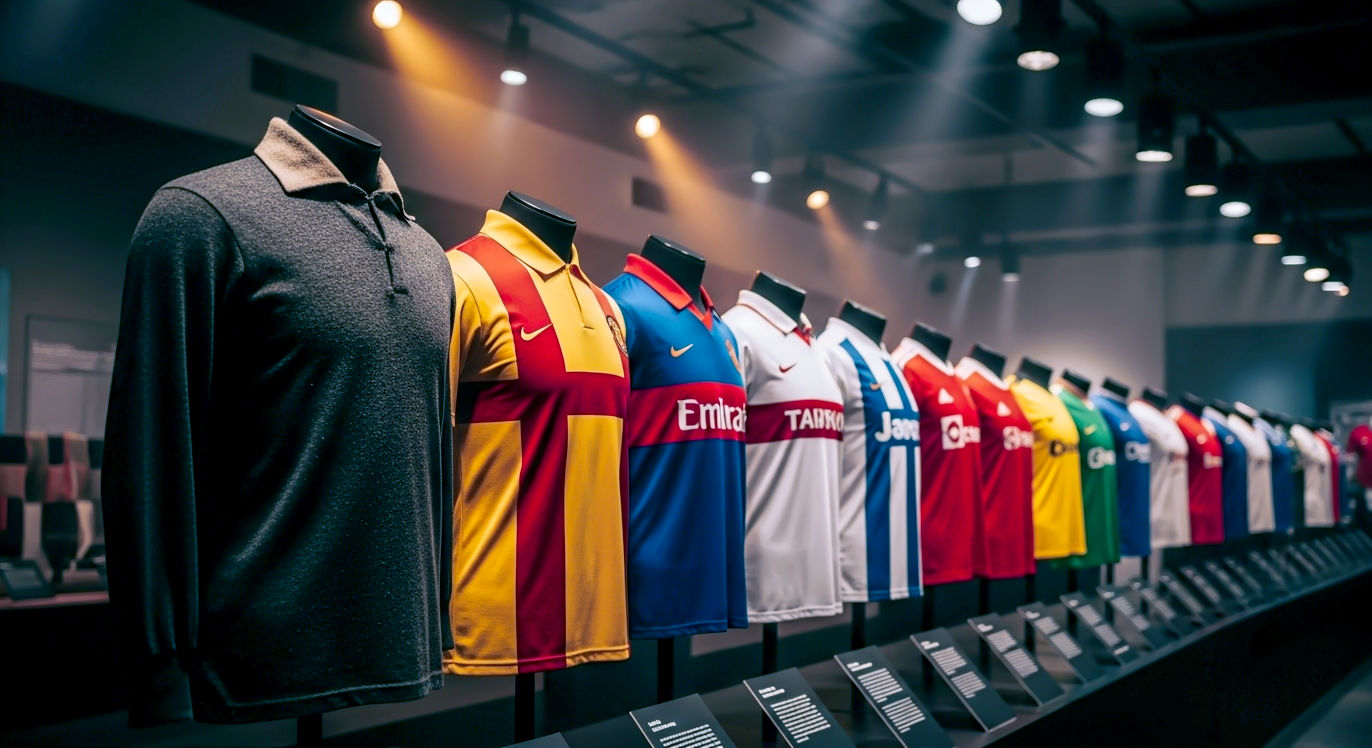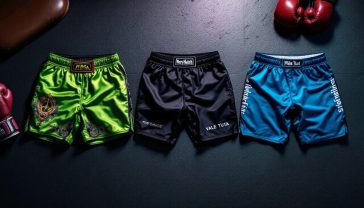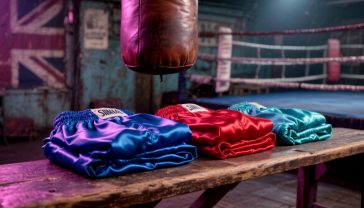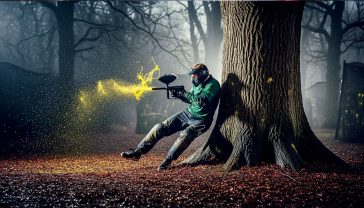From Heavy Wool to High-Tech Wonders: The Great British Story of the Football Kit
Discover the fascinating evolution of the football kit. This definitive guide covers its history, technology, and cultural impact in Britain.

This post may contain affiliate links. If you make a purchase through these links, we may earn a commission at no additional cost to you.
Think of a classic football moment. Maybe it’s Bobby Moore, his face a picture of pure joy, lifting the World Cup at Wembley in 1966. He’s wearing a simple, long-sleeved red shirt. Now, picture a Premier League star today, maybe sprinting down the wing in a blur of luminous colour. Their shirt is skin-tight, made of fabric that looks like it was woven in a science lab, covered in logos and intricate patterns.
The journey between these two images is more than just a change in fashion. It’s the story of football itself. The evolution of the football kit is a tale of technology, money, identity, and culture. It’s a story that takes us from muddy Victorian fields, where men kicked a ball about in their work clothes, to the multi-billion-pound global industry we know today. A football shirt isn’t just something a player wears; it’s a symbol. It’s a tribe’s colours, a city’s pride, and a piece of history all rolled into one. This is the story of how that simple piece of clothing became an icon.
The Early Days: A Mess of Caps, Sashes, and DIY Colours
In the beginning, there was chaos. When football was just getting started in the mid-1800s, there weren’t really any “kits” to speak of. Teams were often formed by old boys from the same public school or workers from a local factory. Getting eleven men on a pitch was the main challenge; what they wore was an afterthought.
When Any Old Top Would Do
Early teams would tell each other apart by wearing coloured caps, sashes over their shoulders, or even just by one team agreeing to play with their sleeves rolled up. Imagine trying to pick out a pass with half your team in flat caps and the other half in bowlers. It was confusing for players, officials, and the handful of spectators on the touchline.
The players’ outfits were their own everyday clothes. That meant heavy work trousers, sturdy boots that were more suited to a building site, and thick, woollen jumpers. There was no thought for performance or comfort. The idea of a lightweight, breathable fabric would have sounded like science fiction.
The FA Steps In: The Birth of “Colours”
As the game became more organised with the founding of the Football Association (FA) in 1863, the rules started to get stricter. One of the early rules stated that teams needed to have distinct “colours” to avoid confusion. This was the birth of the football kit as we know it.
Clubs started to register their official colours. Blackburn Rovers, for example, adopted their famous blue and white halves in 1875. These first “kits” were often made by the players themselves or their families. They were simple, functional, and designed to last. The goal wasn’t to look good; it was simply to tell friend from foe on a murky Saturday afternoon.
Into the 20th Century: Wool, Laces, and Very Long Shorts
As football entered the new century, the kit began to take on a more standardised, if rather uncomfortable, form. For decades, the look of a footballer barely changed, and it was a look defined by one material: wool.
Dressed for a Winter’s Day, Not a Football Match
The standard footballer’s uniform from the early 1900s right up to the 1950s was a heavy woollen jersey. These shirts were thick, scratchy, and didn’t breathe at all. When it rained—which, let’s face it, is a regular feature of British football—they became waterlogged and incredibly heavy. Players would often be carrying several extra pounds of water by the end of a match.
The shirts often had a proper collar and lace-up neck, like a piece of formal wear. Below the waist, things weren’t much better. Footballers wore long, baggy shorts that were more like trousers cut off at the knee, often called “knickerbockers.” These were held up with a belt. Paired with thick, heavy leather boots with hammered-in studs and woolly socks, the whole outfit was incredibly restrictive. It’s a miracle players could run at all, let alone play for 90 minutes.
Numbers on the Back: A Simple Revolution
One of the most important innovations arrived in the 1920s and 30s: numbers on the back of shirts. The first time they were used in a major English match was the 1933 FA Cup Final between Everton and Manchester City. Everton wore numbers 1-11, and City wore 12-22.
It seems so simple now, but it was a game-changer. It allowed fans, commentators, and managers to easily identify players. For decades, the numbers were fixed to positions: the number 9 was the main striker, the number 1 was the goalkeeper, and so on. This tradition became so ingrained in British football culture that we still talk about a “classic number 9” or a “tricky number 7” today.
The Post-War Shift: Lighter, Brighter, and a Bit More Modern
After the Second World War, the world began to change, and football kits slowly started to change with it. The grim austerity of the war years gave way to a new sense of optimism, and new materials and technologies began to trickle into the game.
Saying Goodbye to Heavy Wool
The biggest change was the move away from those dreadful woollen jerseys. Synthetic materials developed during the war started to become available. Clubs began experimenting with lighter cottons and new artificial fibres. These new shirts were a revelation for players. They were lighter, more comfortable, and didn’t hold water in the same way.
Shorts also got, well, shorter. The baggy, knee-length knickerbockers were replaced by much shorter, more practical shorts, giving players more freedom to move. The whole silhouette of the footballer began to look more athletic and modern.
The Age of Simplicity: Umbro and the Classic Look
This era was defined by a clean, simple aesthetic. Think of the great Manchester United team of the 1950s, the “Busby Babes,” in their simple red shirts with a V-neck collar. Or the “Spurs” double-winning side of 1961 in their elegant, plain white kits.
British brands like Umbro and Bukta dominated the market. They produced no-nonsense, high-quality kits that became iconic. There were no flashy patterns or sponsors’ logos. The club crest, often a simple embroidered design, was the only decoration. It was a time of understated style, where the team’s colours were everything.
1966 and Beyond: When Kits Got Commercial
The 1966 World Cup, hosted and won by England, was a watershed moment for football in Britain. The whole country was captivated, and the players became national heroes. And on the back of this success, the football kit started its journey from simple team uniform to commercial product.
England’s Red Shirts and a World Cup Win
The sight of Moore, Hurst, and Charlton in their red long-sleeved shirts is burned into the national memory. It’s perhaps the most iconic kit in British sporting history. What’s interesting is that England wore their red change strip in the final, not their usual white. The kit was made by Umbro, cementing their place as the go-to brand for British teams.
Admiral and the First Replica Kit Boom
Until the 1970s, you couldn’t really buy a replica of your team’s shirt. The kits were made for the players, and that was it. But a small company from Leicester called Admiral changed everything.
In 1973, Admiral struck a deal with Don Revie’s Leeds United, one of the top teams in the country. They designed a new, modern-looking kit for Leeds and, crucially, secured the rights to sell replicas to the public. For the first time, fans could wear the exact same shirt as their heroes.
It was a massive success. Kids (and adults) all over the country wanted one. Admiral quickly signed up Manchester United and the England national team, and the replica kit market was born. They introduced new fabrics like polyester and started putting their own logo on the shirts—a small but revolutionary step.
The Polyester Revolution: The Wild and Wonderful 70s and 80s
If the post-war era was about simplicity, the 70s and 80s were about flamboyant expression. Driven by new materials and the burgeoning replica market, kit design exploded in a riot of colour, patterns, and questionable taste.
A Fabric Revolution: Shiny Shirts and Daring Designs
The key to this era was polyester. This shiny, synthetic material was cheap to produce and could be printed with all sorts of elaborate designs. Designers went to town. We saw the arrival of pinstripes, shadow stripes, and bold, contrasting panels. Coventry City’s infamous brown away kit from the late 70s is a prime example of the era’s adventurous, if sometimes misguided, spirit.
These new kits were a world away from the old woollen jerseys. They were lightweight and colourful, but they weren’t particularly comfortable. The early polyester shirts didn’t breathe well and could feel clingy and sweaty to wear.
The Sponsor Arrives: From Kettering Town to Liverpool and Hitachi
The next commercial revolution was shirt sponsorship. In 1976, non-league Kettering Town became the first British club to put a sponsor’s name on their shirts. The FA was horrified and initially banned it.
But the financial pressure was too great. In 1979, Liverpool signed a deal with Japanese electronics company Hitachi, becoming the first top-flight English club to have a shirt sponsor. Soon, almost every club followed suit. The sponsor’s logo, placed front and centre, became an integral part of the kit’s design and a vital source of income for clubs. It marked the moment the shirt became a piece of advertising real estate.
The Premier League Era: The Gloriously Gaudy 90s
The launch of the Premier League in 1992, fuelled by a huge TV deal with Sky Sports, poured money into English football. The game became more glamorous, more global, and the kits became more outrageous than ever. The 90s are remembered as a golden age of terrible, but brilliant, kit design.
Baggy Fits and Dazzling Patterns
The fashion of the 90s was all about being big and bold, and football kits were no exception. Shirts became incredibly baggy, with long, loose sleeves and collars that you could pop up like Eric Cantona.
Designers used new computer technology to create wild, abstract patterns that often covered the entire shirt. It seemed like there was a competition to see who could come up with the most eye-watering design. From jagged geometric shapes to strange, paint-splatter effects, nothing was off-limits.
Iconic (and Infamous) Kits of the Decade
This era produced some of the most memorable kits of all time, for both good and bad reasons.
- Arsenal’s ‘Bruised Banana’ (1991-93): An away kit so distinctive it’s become a cult classic, loved by fans today.
- Manchester United’s Grey Away Kit (1995-96): Famously ditched at half-time in a match against Southampton after manager Alex Ferguson claimed the players couldn’t see each other against the backdrop of the crowd.
- England’s Euro ’96 Kit: A beautiful, simple design by Umbro that captured the spirit of a summer when football nearly “came home.”
These kits, even the terrible ones, are now looked back on with a strange fondness. They represent a time of fun and experimentation before kits became the serious, high-performance gear of today.
The Noughties: Science Takes Over the Shirt
As we moved into the 21st century, the focus of kit design shifted dramatically. The crazy patterns of the 90s were out, and scientific innovation was in. The big brands like Nike and Adidas, who now dominated the market, began to compete on technology.
From Fashion to Function: The Rise of Performance Wear
The key question was no longer “How does it look?” but “How does it perform?” Brands invested millions in research and development to create fabrics that would give their players a competitive edge.
This led to the creation of technologies like Nike’s Dri-FIT and Adidas’s ClimaCool. These were intelligent fabrics designed to pull sweat away from the body, keeping players cool, dry, and comfortable. They were also incredibly lightweight and often featured mesh panels in key areas to improve ventilation. The shirt was now a piece of high-performance sporting equipment.
Tighter Fits and Breathable Fabrics
The baggy look of the 90s was replaced by much tighter, more athletic fits. Italy’s “Kombat” kit for Euro 2000 was a prime example—a skin-tight shirt that was designed to make it harder for opponents to pull a player’s jersey.
Designs became much more minimalist and clean. The focus was on sleek lines and subtle details. The era of crazy patterns was over, replaced by an age of scientific precision.
The Modern Kit: More Than Just a Shirt
Today, the football kit is a complex beast. It’s a piece of advanced technology, a fashion item, and a huge commercial driver for clubs. The modern fan has more choice, and more kits to buy, than ever before.
The Three-Kit Season: A Commercial Powerhouse
It used to be simple: a home kit and an away kit. Now, it’s standard for top clubs to release a home, away, and third kit every single season. Sometimes there’s even a fourth. These kits are often launched with huge marketing campaigns and are a massive source of revenue.
The third kit, in particular, has become a space for designers to be more experimental, often featuring bold colours and patterns that have little to do with the club’s traditional colours. They are designed to be worn on the pitch, but also as fashion items on the street.
Retro is the New Modern: Borrowing from the Past
One of the biggest trends in recent years has been the rise of retro-inspired designs. Kit manufacturers have realised that fans have a deep affection for the classic kits of the past.
Modern kits now frequently include nods to iconic designs from the 70s, 80s, and 90s. This might be a collar style from a classic shirt, a subtle pattern inspired by a past favourite, or a return to a beloved shade of colour. It’s a clever way of blending modern performance technology with the nostalgia and history that fans love.
Green Goals: The Push for Sustainable Kits
The latest frontier in kit design is sustainability. With growing awareness of environmental issues, fans and clubs are demanding more eco-friendly products. Brands are now making kits from recycled materials, often using plastic bottles recovered from the ocean. This push towards sustainability is likely to be a key driver of innovation in the years to come.
The Science Behind the Shirt: How a Modern Kit is Made
So, what actually makes a modern kit different from the old woollen jerseys? It’s all about the science of the fabric.
A Simplified Look at Kit Technology
Think of a modern football shirt like a clever sponge. The fabric is a special type of polyester made of tiny microfibres. When a player sweats, these fibres use a process called “capillary action” to pull the moisture from the skin and spread it across the surface of the fabric. Because it’s spread so thinly, the sweat can evaporate much faster, keeping the player cool.
The shirts are also designed for an athletic fit. They are often laser-cut and bonded together with heat rather than stitched, which reduces chafing and makes them lighter. Different panels of the shirt might have different properties—some parts might be more stretchy, while others have tiny holes for ventilation.
The Difference Between a Player’s Shirt and Yours
If you buy a top-of-the-range kit, you might be offered two versions: an “authentic” or “player issue” version, and a “replica” or “stadium” version.
- The Authentic Shirt: This is the exact same shirt the players wear on the pitch. It has all the latest technology, is made from the lightest materials, and has a slim, athletic fit.
- The Replica Shirt: This is designed for the fans. It’s made from a slightly heavier, more durable fabric and has a more relaxed, comfortable fit. It still has sweat-wicking technology, but it’s built for wearing in the stands or down the pub, not for 90 minutes of intense athletic performance.
More Than a Uniform: What a Kit Means to a Fan
We’ve talked a lot about technology and design, but we can’t forget what a football kit really means. It’s the fabric that connects generations of supporters.
A Badge of Honour and a Tribal Identity
Putting on your team’s shirt is a declaration of loyalty. It’s a way of saying, “This is my tribe.” When fans gather on match day, they create a sea of colour that is a powerful expression of collective identity and belonging. The club crest on the chest is a badge of honour, worn with pride through victories and defeats.
A kit can define an era. Ask any fan, and they’ll be able to tell you about their first ever shirt, or the one the team wore when they won that famous cup final. Kits are woven into the personal and collective memory of football supporters.
The Cost of Colour: Are Fans Being Priced Out?
The downside to all this technology and marketing is the price. A new adult replica shirt from a top Premier League club can now cost £80 or more. For a family, buying the new season’s kits can be a major expense.
There is an ongoing debate about whether the cost of kits is becoming too high, pricing out loyal, lifelong fans. While clubs argue the revenue is essential, many supporters feel that the commercialisation has gone too far, turning a symbol of loyalty into just another expensive consumer product.
Conclusion: The Future of the Football Kit
The football kit has come a long way from the days of wool and belts. So, what’s next?
Technology will continue to push things forward. We might see “smart” kits with embedded sensors that can track a player’s heart rate or performance data. Fabrics will become even lighter, more breathable, and more sustainable.
Perhaps we’ll see more customisation, where fans can design their own versions of kits. And the debate over cost and commercialism will certainly continue.
But whatever the future holds, one thing will remain the same. The football kit will always be more than just a shirt. It’s a canvas for our memories, a symbol of our identity, and the vibrant, colourful thread that ties the past, present, and future of the beautiful game together.
Further Reading:
- Historical Football Kits – An exhaustive visual database of British football kits throughout history.
- The National Football Museum – Explore the museum’s collection of iconic shirts and football history.
- Classic Football Shirts – A leading retailer and archive for vintage and classic football kits.






